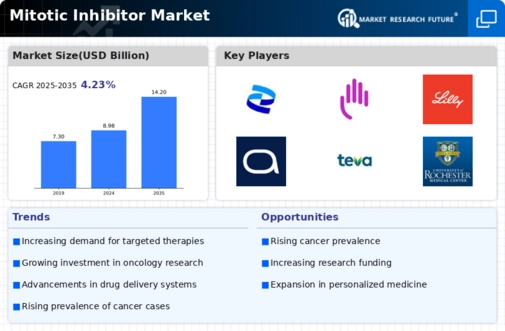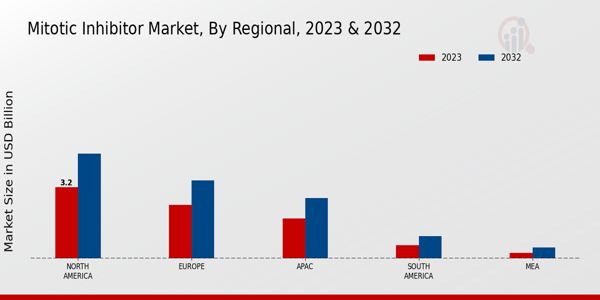Rising Cancer Incidence
The Global Mitotic Inhibitor Market Industry is significantly influenced by the increasing incidence of cancer worldwide. According to the World Health Organization, cancer cases are projected to rise, with an estimated 19.3 million new cases expected in 2024. This alarming trend drives demand for effective treatment options, including mitotic inhibitors, which play a crucial role in cancer therapy. As healthcare systems adapt to this growing burden, the market for mitotic inhibitors is anticipated to expand, contributing to a projected market value of 8.98 USD Billion in 2024. This growth underscores the urgent need for innovative therapies to combat cancer.
Market Growth Projections
Advancements in Drug Development
Innovations in drug development are propelling the Global Mitotic Inhibitor Market Industry forward. Recent advancements in biotechnology and pharmacology have led to the discovery of novel mitotic inhibitors that target specific cancer pathways. For instance, the development of targeted therapies has shown promise in improving patient outcomes and minimizing side effects. As a result, the market is expected to witness a compound annual growth rate of 4.23% from 2025 to 2035. This growth is indicative of the industry's commitment to enhancing treatment efficacy and safety, ultimately benefiting patients and healthcare providers alike.
Regulatory Support for Drug Approvals
Regulatory agencies are increasingly supportive of the approval processes for new cancer therapies, which is advantageous for the Global Mitotic Inhibitor Market Industry. Streamlined approval pathways and expedited review processes are being implemented to bring innovative treatments to market more quickly. For instance, the U.S. Food and Drug Administration has introduced initiatives to facilitate the development of breakthrough therapies. This regulatory environment encourages pharmaceutical companies to invest in mitotic inhibitors, fostering market growth. As a result, the industry is poised for expansion, with new therapies expected to emerge in the coming years.
Growing Awareness of Cancer Treatments
Public awareness regarding cancer treatments is on the rise, positively impacting the Global Mitotic Inhibitor Market Industry. Educational campaigns and advocacy efforts have led to increased understanding of available treatment options, including mitotic inhibitors. As patients become more informed, they are more likely to seek these therapies, driving demand. This trend is particularly evident in regions with previously limited access to cancer care. Consequently, the market is expected to grow as healthcare providers respond to this demand, ensuring that patients receive timely and effective treatment.
Increasing Investment in Oncology Research
The Global Mitotic Inhibitor Market Industry is bolstered by rising investments in oncology research. Governments and private organizations are allocating substantial resources to cancer research initiatives, aiming to uncover new treatment modalities. For example, the National Cancer Institute has significantly increased funding for cancer research projects, fostering innovation in mitotic inhibitors. This influx of capital is likely to accelerate the development of new therapies, thereby expanding the market. By 2035, the market is projected to reach 14.2 USD Billion, reflecting the positive impact of sustained investment in oncology research and development.














